Bond LSC Research

June 10, 2014
SoyKB: Leading the convergence of wet and dry science in the era of Big Data
Yaya Cui, an investigator in plant sciences at the Bond Life Sciences Center examines data on fast neuron soybean mutants that are represented on the SoyKB database. The most puzzling scientific mysteries may be solved at the same machine you’re likely reading this sentence. In the era of “Big Data” many significant scientific discoveries — the development of new drugs to fight diseases, strategies of agricultural breeding to solve world-hunger problems and figuring out why the world exists — are being made without ever stepping foot in a lab. Developed by researchers at the Bond Life…

June 4, 2014
MU Scientists Successfully Transplant, Grow Stem Cells in Pigs
New line of pigs do not reject transplants, will allow for future research on stem cell therapies Story by Nathan Hurst/MU News Bureau COLUMBIA, Mo. – One of the biggest challenges for medical researchers studying the effectiveness of stem cell therapies is that transplants or grafts of cells are often rejected by the hosts. This rejection can render experiments useless, making research into potentially life-saving treatments a long and difficult process. Now, researchers at the University of Missouri have shown that a new line of genetically modified pigs will host transplanted cells without the risk of rejection.

May 12, 2014
New screening tool gives scientists more control over genetic research
A tangled spool of yarn represents DNA, while the fingers holding the section represent the insulators just added by MU researchers to improve a scientific, screening tool. | Paige Blankenbuehler Here’s a scenario: You are trying to find a lost section of string in the world’s most massively tangled spool of yarn. Then try cutting that section of yarn that’s deeply embedded in the mess without inadvertently cutting another or losing track of the piece you’re after. For researchers, this problem is not unlike something they encounter in the study of genetic information in the tangled…
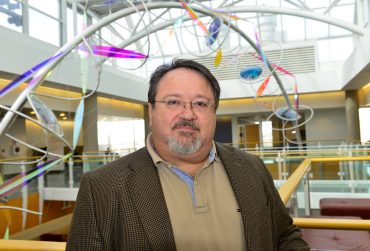
April 28, 2014
A drug that packs a punch: new compound works better against resistant HIV
Bond LSC researcher Stefan Sarafianos stands in the LSC atrium. The virologist is an associate professor of molecular microbiology and immunology and Chancellor’s Chair of Excellence in Molecular Virology with appointments in MU’s School of Medicine and the Department of Biochemistry. Resistance is the price of success when it comes to treating HIV. Virologists at the Bond Life Sciences Center are helping to test the next generation of anti-AIDS medication to quell that resistance. Stefan Sarafianos’ lab recently proved that EFdA, a compound that stops HIV from spreading, is 70 times more potent against some HIV…
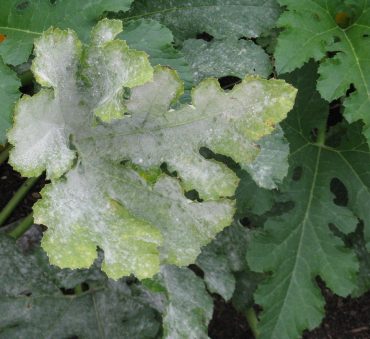
April 25, 2014
Frogs help researchers find genetic mechanism for mildew susceptibility in grapevine
Powdery mildew on a cabernet sauvignon grapevine leaf. | USDA Grape genetics publications and research A princess kisses a frog and it turns into a prince, but when a scientist uses a frog to find out more information about a grapevine disease, it turns into the perfect tool narrowing in on the cause of crop loss of Vitis vinifera, the world’s favorite connoisseur wine-producing varietal. MU researchers recently published a study that uncovered a specific gene in the Vitis vinifera varietal Cabernet Sauvingon, that contributes to its susceptibility to a widespread plant disease, powdery mildew.
April 24, 2014
Chemical beacons: LSC scientist discovers how plants beckon bacteria to attack
Scott Peck, Bond LSC scientist and associate professor of biochemistry, studies Arabidopsis and how bacteria perceive it before initiating an infection. Roger Meissen/ Bond LSC Sometimes plants inadvertently roll out the red carpet for bacteria. Researchers at the University of Missouri Bond Life Sciences Center recently discovered how a plant’s own chemicals act as a beacon to bacteria, triggering an infection. Proceedings of the National Academy of Sciences published their study April 21. “When bacteria recognize these plant chemicals it builds a needle-like syringe that injects 20-30 proteins into its host, shutting down the plant’s…
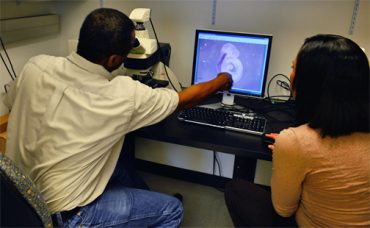
March 21, 2014
MU researchers find key gene in spinal locomotion, yield insight on paralysis
Samuel Waters and graduate researcher Desiré Buckley review stages of embryonic development. — BLANKENBUEHLER The difference between walking and being paralyzed could be as simple as turning a light switch on and off, a culmination of years of research shows. Recently, University of Missouri Assistant Professor of biology Samuel T. Waters isolated a coding gene that he found has profound effects on locomotion and central nervous system development. Waters’ work with gene expression in embryonic mouse tissue could shed light on paralysis and stroke and other disorders of the central nervous system, like Alzheimer’s disease. Waters…
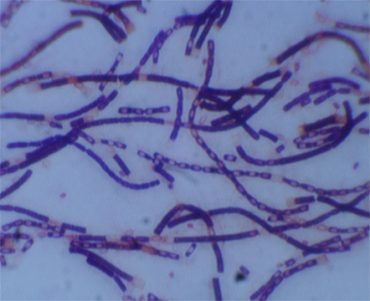
Feb. 7, 2014
Quicker anthrax detection could save millions of dollars, speed bioterror response
Anthrax bacteria is a rod-shaped culture. Most common forms of transmission are through abrasions in the skin and inhalation. Imagine researchers in hazmat suits moving slowly and deliberately through a lab. One of them holds up a beaker. It’s glowing. This light — or the absence of it — could save millions of dollars for governments and save the lives of anthrax victims. Scientists at the University of Missouri Laboratory of Infectious Disease Research proved a new method for anthrax detection can identify anthrax quicker than any existing approach. When the “bioluminescent reporter phage” —…
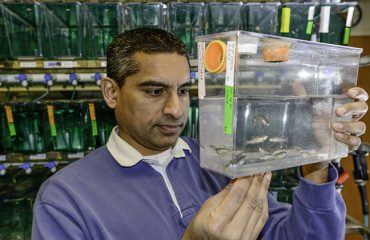
Feb. 3, 2014
Mind map: Bond LSC research explains how proteins guide migrating neurons
Bond LSC scientist Anand Chandrasekhar studies the zebrafish model to learn how motor neurons develop. These adult zebrafish lay eggs used to gain insight into how motor neurons arrange themselves as embryos grow into adults. Roger Meissen/ Bond LSC Three thousand zebrafish swim circles in tanks located on the ground floor of the Bond Life Sciences Center, content to mindlessly while away their existence by eating their fill and laying eggs. Despite their very basic higher functions, Bond LSC researcher Anand Chandrasekhar wants to understand how their brains work. More importantly, he wants to know how individual…
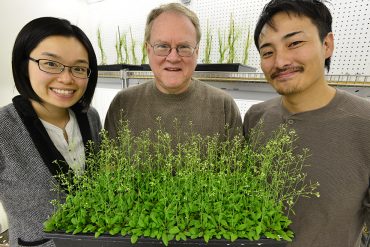
Jan. 16, 2014
Bond LSC team identifies first plant receptor for extracellular ATP
Jeongmin Choi (left), Gary Stacey (center) and Kiwamu Tanaka recently discovered the first plant receptor for extracellular ATP using Arabidopsis plants. Roger Meissen/Bond LSC It’s the genetic equivalent to discovering a new sensory organ in plants. A team at the University of Missouri Bond Life Sciences Center found a key gene that sniffs out extracellular ATP. Scientists believe this is a vital way plants respond to dangers, such as insects chewing on its leaves. The journal Science published their research Jan. 17. “Plants don’t have ears to hear, fingers to feel or eyes to see. They recognize…
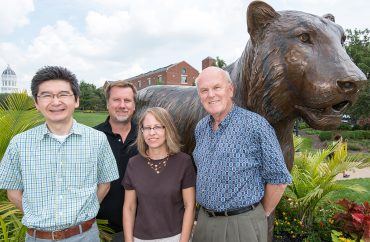
Jan. 13, 2014
Bond LSC researchers search for causes of complex pregnancy disorder
Toshihiko Ezashi (left), Danny Schust (middle), Laura Schulz (middle) and Michael Roberts (right) collaborate on new research to discover the causes of preeclampsia. Roger Meissen/ Bond LSC You can’t see the resemblance, but cells in Michael Roberts’ lab share a family tree with some newborns. Their common genetics may help explain severe, early-onset preeclampsia, an inherited disorder that leads to a placenta that is often small and inefficient and possibly due to the mother’s body not fully welcoming her pregnancy. University of Missouri Health Center scientists such as Danny Schust and Laura Schulz, work with Roberts and…
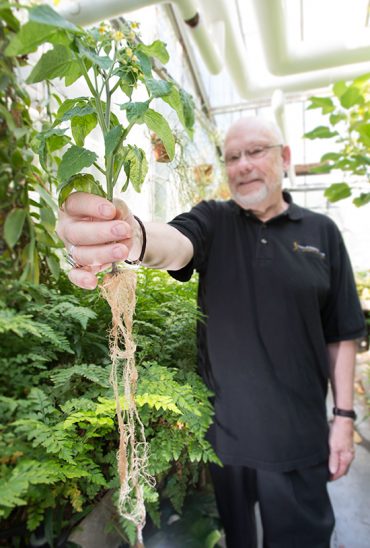
Nov. 22, 2013
The sweet path: how scientists try to understand sugar movement in plants
Roots play a key role in regulating where sugar ends up in plants like tomato. Plant scientists are borrowing a tool from medicine to unravel how plants fight off an attack. The Schultz-Appel Chemical Ecology lab used PET scans to decipher how and when a plant uses resources to fight off a disease or insect. Positron emission tomography (PET) scans detect radioactive tracers and how they travel over time. In humans the scan tracks blood flow to find cancers, understand brain activity and show uptake…